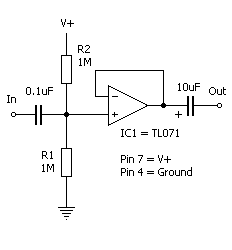I'm pretty shaky on my electronics theory and wanted to check in on this.
I am drawing up a simple buffer for a Jazz bass using a dual opamp - one side for each pickup. I was looking at building blocks for a starting point and thought maybe I could omit an input cap, because it seems there is going to be no DC offset from a simple coil, right?
I am drawing up a simple buffer for a Jazz bass using a dual opamp - one side for each pickup. I was looking at building blocks for a starting point and thought maybe I could omit an input cap, because it seems there is going to be no DC offset from a simple coil, right?

Comment